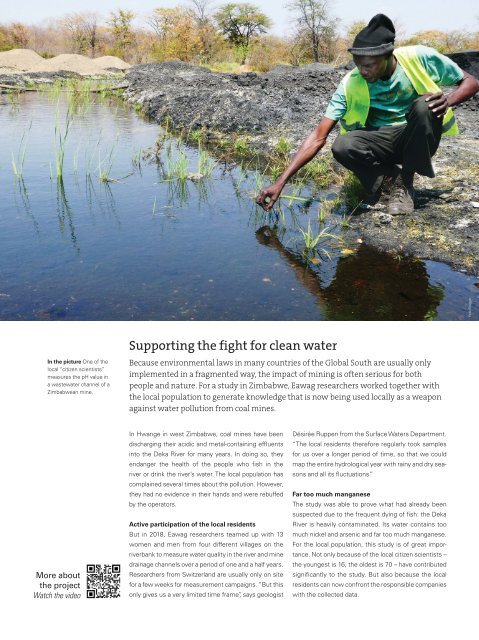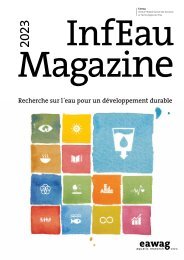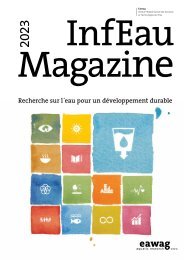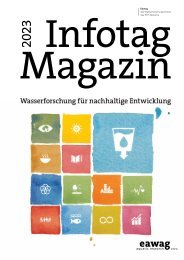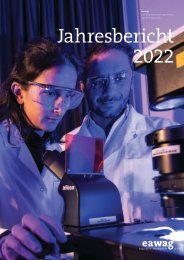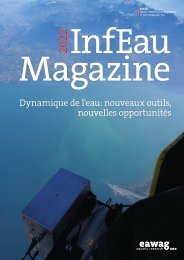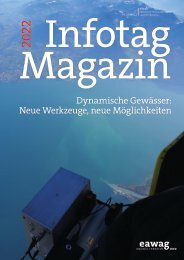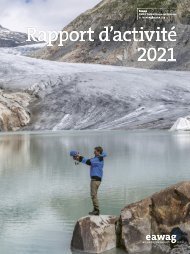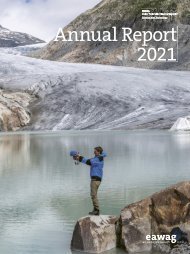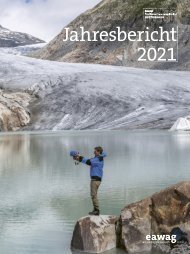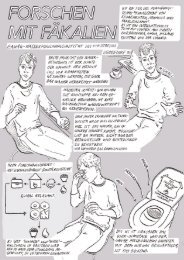Eawag Annual Report 2022
As the aquatic research institute of the ETH Domain, our research is in service of society. You can see this for yourself in our Annual Report. The annual compact review highlights the most relevant research results of the past year and shows how they were developed.
As the aquatic research institute of the ETH Domain, our research is in service of society. You can see this for yourself in our Annual Report. The annual compact review highlights the most relevant research results of the past year and shows how they were developed.
You also want an ePaper? Increase the reach of your titles
YUMPU automatically turns print PDFs into web optimized ePapers that Google loves.
Fritz Brugger<br />
Supporting the fight for clean water<br />
In the picture One of the<br />
local “citizen scientists”<br />
measures the pH value in<br />
a wastewater channel of a<br />
Zimbabwean mine.<br />
Because environmental laws in many countries of the Global South are usually only<br />
implemented in a fragmented way, the impact of mining is often serious for both<br />
people and nature. For a study in Zimbabwe, <strong>Eawag</strong> researchers worked together with<br />
the local population to generate knowledge that is now being used locally as a weapon<br />
against water pollution from coal mines.<br />
More about<br />
the project<br />
Watch the video<br />
In Hwange in west Zimbabwe, coal mines have been<br />
discharging their acidic and metal-containing effluents<br />
into the Deka River for many years. In doing so, they<br />
endanger the health of the people who fish in the<br />
river or drink the river’s water. The local population has<br />
complained several times about the pollution. However,<br />
they had no evidence in their hands and were rebuffed<br />
by the operators.<br />
Active participation of the local residents<br />
But in 2018, <strong>Eawag</strong> researchers teamed up with 13<br />
women and men from four different villages on the<br />
riverbank to measure water quality in the river and mine<br />
drainage channels over a period of one and a half years.<br />
Researchers from Switzerland are usually only on site<br />
for a few weeks for measurement campaigns. “But this<br />
only gives us a very limited time frame”, says geologist<br />
Désirée Ruppen from the Surface Waters Department.<br />
“The local residents therefore regularly took samples<br />
for us over a longer period of time, so that we could<br />
map the entire hydrological year with rainy and dry seasons<br />
and all its fluctuations.”<br />
Far too much manganese<br />
The study was able to prove what had already been<br />
suspected due to the frequent dying of fish: the Deka<br />
River is heavily contaminated. Its water contains too<br />
much nickel and arsenic and far too much manganese.<br />
For the local population, this study is of great importance.<br />
Not only because of the local citizen scientists –<br />
the youngest is 16, the oldest is 70 – have contributed<br />
significantly to the study. But also because the local<br />
residents can now confront the responsible companies<br />
with the collected data.


